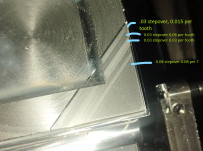usolutions
Cast Iron
- Joined
- Nov 25, 2020
- Location
- Riga, Latvia
I have a question regarding achievable surface finish in aluminium. I am currently running 3mm ball solid carbide endmill 2fl polished from haas shop, 0.075mm/fl, 0,075mm stepover, 15000rpm. Stock to leave from previous operation 0.25mm. I am getting quite smooth finish, but it is not, lets say bright or mirror-like. Am i missing somethin here? Part calls for R5mm internal fillets with sharp corners of R1.5mm.
Or getting smooth matte finish is to be expected? Or some kind of tool change/cutting mode is required for better finish. I dont have porfileometer at hand, can not give exact Ra value.
Or getting smooth matte finish is to be expected? Or some kind of tool change/cutting mode is required for better finish. I dont have porfileometer at hand, can not give exact Ra value.



